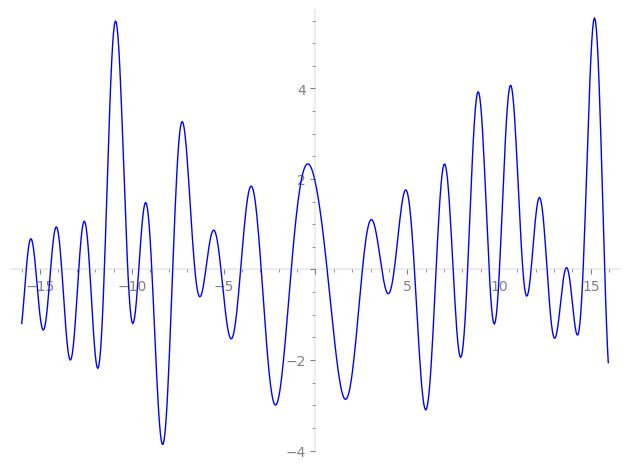| L(s) = 1 | + (1.15 + 0.668i)2-s + (−1.10 − 1.91i)4-s + (−4.10 + 7.10i)7-s − 8.30i·8-s + (5.67 + 3.27i)11-s + (−0.749 − 1.29i)13-s + (−9.50 + 5.49i)14-s + (1.13 − 1.97i)16-s + 15.1i·17-s + 25.9·19-s + (4.38 + 7.58i)22-s + (−20.1 + 11.6i)23-s − 2.00i·26-s + 18.1·28-s + (6.96 + 4.02i)29-s + ⋯ |
| L(s) = 1 | + (0.579 + 0.334i)2-s + (−0.276 − 0.478i)4-s + (−0.586 + 1.01i)7-s − 1.03i·8-s + (0.515 + 0.297i)11-s + (−0.0576 − 0.0998i)13-s + (−0.679 + 0.392i)14-s + (0.0710 − 0.123i)16-s + 0.889i·17-s + 1.36·19-s + (0.199 + 0.344i)22-s + (−0.873 + 0.504i)23-s − 0.0771i·26-s + 0.647·28-s + (0.240 + 0.138i)29-s + ⋯ |
\[\begin{aligned}\Lambda(s)=\mathstrut & 675 ^{s/2} \, \Gamma_{\C}(s) \, L(s)\cr =\mathstrut & (0.277 - 0.960i)\, \overline{\Lambda}(3-s) \end{aligned}\]
\[\begin{aligned}\Lambda(s)=\mathstrut & 675 ^{s/2} \, \Gamma_{\C}(s+1) \, L(s)\cr =\mathstrut & (0.277 - 0.960i)\, \overline{\Lambda}(1-s) \end{aligned}\]
Particular Values
| \(L(\frac{3}{2})\) |
\(\approx\) |
\(1.911513575\) |
| \(L(\frac12)\) |
\(\approx\) |
\(1.911513575\) |
| \(L(2)\) |
|
not available |
| \(L(1)\) |
|
not available |
\(L(s) = \displaystyle \prod_{p} F_p(p^{-s})^{-1} \)
| $p$ | $F_p(T)$ |
|---|
| bad | 3 | \( 1 \) |
| 5 | \( 1 \) |
| good | 2 | \( 1 + (-1.15 - 0.668i)T + (2 + 3.46i)T^{2} \) |
| 7 | \( 1 + (4.10 - 7.10i)T + (-24.5 - 42.4i)T^{2} \) |
| 11 | \( 1 + (-5.67 - 3.27i)T + (60.5 + 104. i)T^{2} \) |
| 13 | \( 1 + (0.749 + 1.29i)T + (-84.5 + 146. i)T^{2} \) |
| 17 | \( 1 - 15.1iT - 289T^{2} \) |
| 19 | \( 1 - 25.9T + 361T^{2} \) |
| 23 | \( 1 + (20.1 - 11.6i)T + (264.5 - 458. i)T^{2} \) |
| 29 | \( 1 + (-6.96 - 4.02i)T + (420.5 + 728. i)T^{2} \) |
| 31 | \( 1 + (-22.5 - 38.9i)T + (-480.5 + 832. i)T^{2} \) |
| 37 | \( 1 - 62.8T + 1.36e3T^{2} \) |
| 41 | \( 1 + (9.97 - 5.75i)T + (840.5 - 1.45e3i)T^{2} \) |
| 43 | \( 1 + (21.3 - 36.9i)T + (-924.5 - 1.60e3i)T^{2} \) |
| 47 | \( 1 + (-14.2 - 8.25i)T + (1.10e3 + 1.91e3i)T^{2} \) |
| 53 | \( 1 - 66.0iT - 2.80e3T^{2} \) |
| 59 | \( 1 + (-0.373 + 0.215i)T + (1.74e3 - 3.01e3i)T^{2} \) |
| 61 | \( 1 + (-15.7 + 27.3i)T + (-1.86e3 - 3.22e3i)T^{2} \) |
| 67 | \( 1 + (-47.9 - 83.1i)T + (-2.24e3 + 3.88e3i)T^{2} \) |
| 71 | \( 1 + 84.2iT - 5.04e3T^{2} \) |
| 73 | \( 1 - 63.5T + 5.32e3T^{2} \) |
| 79 | \( 1 + (9.06 - 15.7i)T + (-3.12e3 - 5.40e3i)T^{2} \) |
| 83 | \( 1 + (87.4 + 50.4i)T + (3.44e3 + 5.96e3i)T^{2} \) |
| 89 | \( 1 + 86.3iT - 7.92e3T^{2} \) |
| 97 | \( 1 + (34.5 - 59.7i)T + (-4.70e3 - 8.14e3i)T^{2} \) |
| show more | |
| show less | |
\(L(s) = \displaystyle\prod_p \ \prod_{j=1}^{2} (1 - \alpha_{j,p}\, p^{-s})^{-1}\)
Imaginary part of the first few zeros on the critical line
−10.22388850498007409019948867626, −9.626176890147571438541468939845, −8.914853291064190090899898371583, −7.77648642406345426546666234797, −6.56967815436670962019758494833, −5.97340786200493665483998934271, −5.14796761249529624917463669947, −4.07543229799293666005546479386, −2.95426268314180189361457728693, −1.31828515013168977544875717096,
0.63567369491801050999517334574, 2.55788225252576684173263425729, 3.61585075836221266151573590522, 4.29258308266352057554004458891, 5.39158086097710134607988385679, 6.57184919219075176555493084538, 7.50056309926879618795354670363, 8.288159365356896722150846262775, 9.459755757960132110556433718961, 10.02237790000533282732533723106

